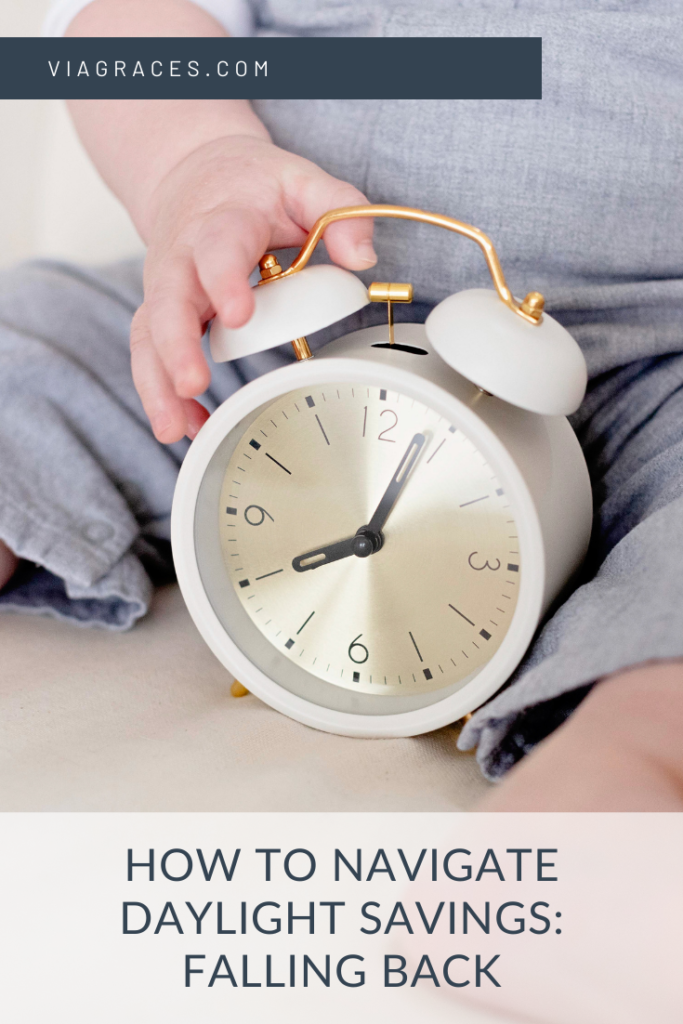I hate to break the news to you, but it’s my responsibility to remind you…Daylight Saving Time is coming. If you’re not ready to think about it yet or don’t want to think about it, then just get out of this post and read another one.
But if you want to start wrapping your mind around falling back and keeping your kid’s sleep as intact as possible, this is for you!
In just a week and a half, all of our clocks will “fall back” early Sunday morning, while we’re all (hopefully!) still sleeping.
Before having kids, I LOVED when it was time to fall back every year because that meant an extra hour of sleep! And who doesn’t love more sleep??
As a parent, however, daylight savings makes us shake our fists at whoever decided it was a good idea to change the clocks twice a year, and whoever has decided to keep it around. Although I still don’t like it, it IS possible to navigate with kids’ sleep and not go totally insane!
So in this post I will explain:
- When it’s best to start adjusting your child’s sleep for falling back
- How to fall back with babies on an awake window schedule
- How to fall back with babies and toddlers on a set nap schedule
- How to fall back with older kids who no longer nap
And more!
If you’re already thinking this seems crazy and people shouldn’t freak out about falling back, guess what?? There are even people who just kind of wing daylight savings, and we usually all end up on the other side eventually.
So if the idea of a planned adjustment stresses you out more than just winging it, you do you!!
When to Start Adjusting Your Child’s Sleep for Daylight Savings
First, let’s just make clear what will be happening…while we’re all sleeping on Sunday, our clocks will change – they will “fall back” an hour. So if your body usually wakes you up at 6:30 am, your phone will actually read 5:30 am. Or if your human alarm clocks usually wakes up at 6:30, your phone will say 5:30 when you wake up.
The confusing thing is, any alarm clocks or microwave or oven clocks are still going to say 6:30, so cue all the confusion! But it’s happening to most of us, so remember we’re all in this together.
Some people like to start adjusting their child’s schedule before daylight savings so that once the clocks officially fall back, their little one is adjusted. If that works better for your family or your schedule, do it! I personally prefer to wait to make any changes until the clocks have actually shifted.
It’s tough enough to do the math after we fall back, let alone having to figure out what time it will be next week at this point.
So for your sake, I suggest not even changing the clocks the night before daylight saving time. Wait until you’ve woken up and had your shower, morning devotional, coffee, tea, exercise, etc. Your phone will of course change overnight, but don’t stress about the real clocks until morning.
And then start everyone’s day from there.
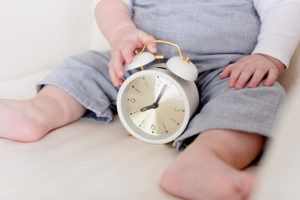
Falling Back with Babies on an Awake Window Schedule
If your newborn or baby is on a “schedule” according to awake windows, then it’s pretty simple! Keep your little one on that same awake window schedule and focus on slowly pushing the morning wake-up time later and later (read below).
Bedtime
If you have a newborn, you likely won’t notice daylight savings all that much – they’re eating and sleeping on repeat and they’re really not on a schedule, so just keep doing what you’re doing.
If your baby is four months or older, you will notice it a bit more as their circadian rhythm is a lot more developed. And around four months old is when I suggest parents aim for their baby’s bedtime to fall between 6:30-8:00 pm, and that just depends on when their last nap of the day lands.
For the first few days after the time change, you may find that your baby’s bedtime is landing around 5:30-7:00 pm based on their last nap, and that’s understandable…to them it feels an hour later. We want to be careful with overtiredness, but try to push your babe just a bit, to even get to a 6 pm bedtime. And as the days go on, they will continue to adjust.
What About Mornings?
Similar to bedtime, I recommend families with babies four months and older start the day between 6:00-7:30 am. When the clocks fall back, your baby might be waking between 5-6:30 am…rough, but again, understandable!
So when they wake up early on Sunday, go ahead and get them up for the day (unless, of course, they’re content, then certainly wait!). As the days go on, try to push the time you actually get them up in the morning a bit later and later, inching closer to that 6:00-7:30 am window, so they don’t get set in thinking 5:00/5:30 am is the new normal wake up time.
It’s all about retraining their little body clocks! Here’s a sample schedule for you:
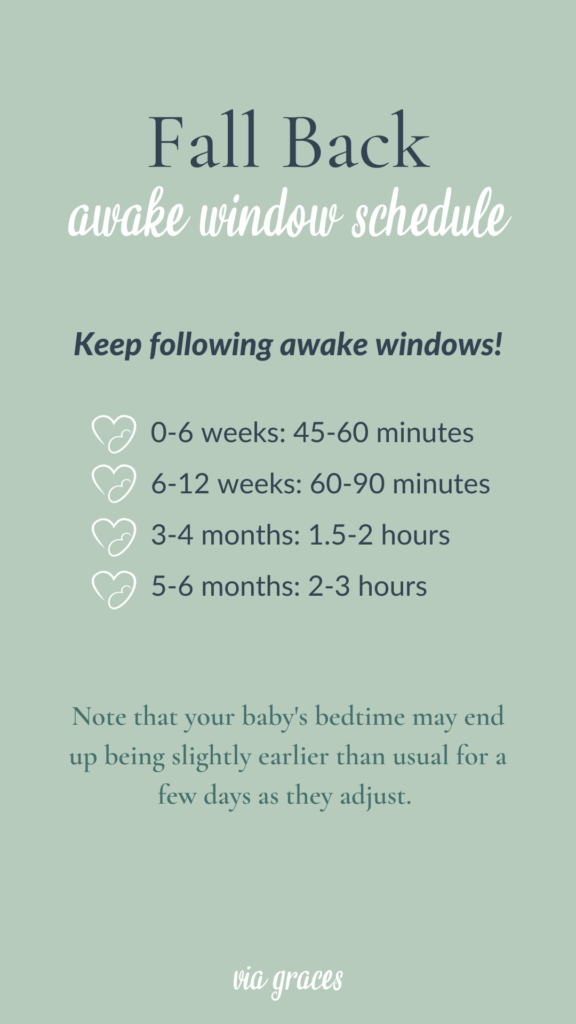
Confused about where to even begin with your baby’s schedule? Snag the (FREE!) Ultimate Guide to Baby Sleep Schedules now!
Falling Back with Babies and Toddlers on a Set Nap Schedule
If you have a baby or toddler who is on a clock-based schedule, however, your best bet is to adjust your child’s schedule by pulling it 30 minutes earlier for the first three days after the time change. And then on day four, adjust naps and bedtime back to your child’s normal schedule.
Bedtime
The clock changes while we’re sleeping on Saturday night/Sunday morning, so on Sunday, Monday, and Tuesday, pull your child’s nap time(s) and bedtime 30 minutes earlier (30 minutes earlier according to the clock, which will actually feel like 30 minutes later to their body).
For example, if your child usually goes to bed at 7:00, pull that time to 6:30 for three days (it will feel like 7:30 to them).
Do the Same for Naps!
If your child usually takes an afternoon nap at 12:00, pull that nap to 11:30 for three days. It might be a push for your little one, but not so much that it will ruin their sleep and their schedule.
What About Mornings?
Your child will inevitably wake up about an hour “earlier” than usual, according to the new time, and that’s understandable – body clocks are strong! That means if they usually wake up around 7 am, they’ll likely wake closer to 6 am for the first few days.
When they wake up around 6 am on Sunday, go ahead and get them up for the day (unless, of course, they’re content, then you can certainly wait longer!). If they wake up around 6 am again on Monday, try not to rush in the moment you hear them wake up – we don’t want them learning that waking up at 6:00 is the new norm!
Instead, try to wait about 15 minutes before going to get them and then start the day. If they wake up at 6:00 again on morning two, try to wait closer to 30 minutes to get them, and so on.
We are retraining their little body clock for a new wake-up time!
By the end of the week, your child’s schedule should be adjusted to the time change and they will likely start waking up at their usual hour. Here’s a sample schedule for you:
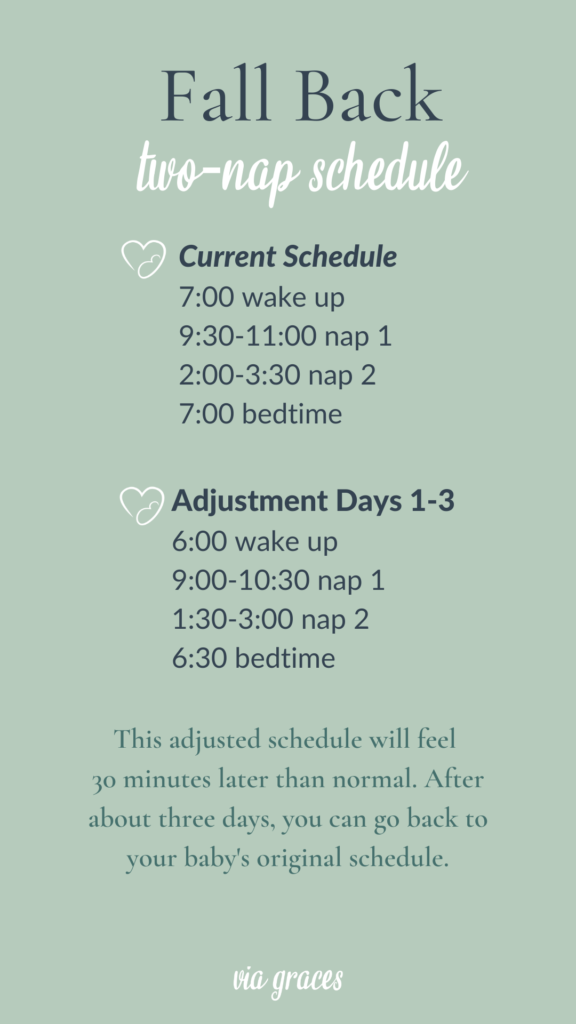
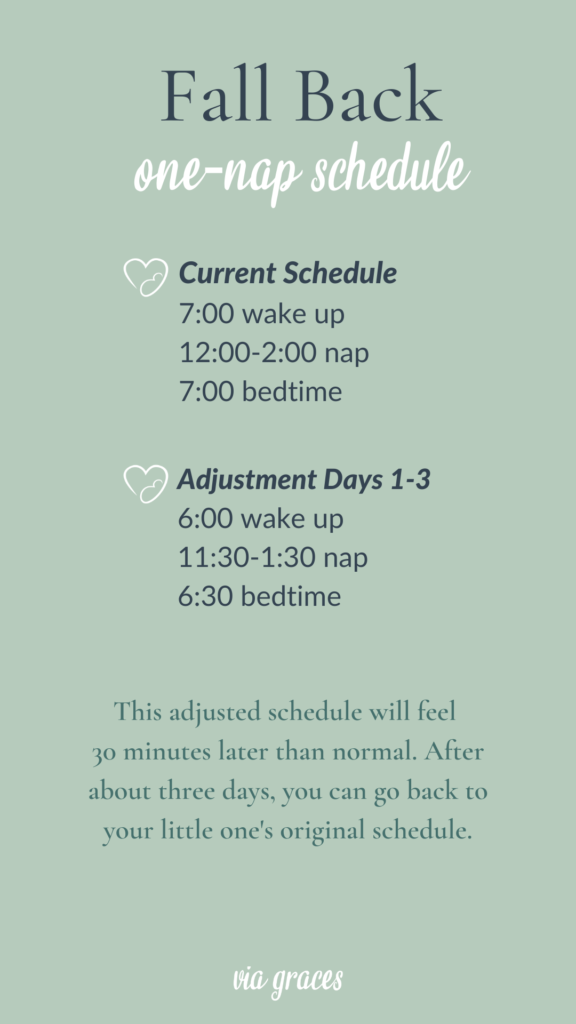
Falling Back with Children No Longer Taking Naps
If you have an older child who doesn’t nap anymore, I also suggest shifting their schedule about 30 minutes earlier to help them adjust. The nice thing is, they won’t be as sensitive to the change!
Bedtime
If your child is usually in bed by 7:00 pm, move his bedtime to 6:30 pm for three days (this will feel like 7:30 pm), then on the fourth day make bedtime 7:00 pm again.
What About Mornings?
I suggest adjusting mornings similarly, trying to push their wake-up time by about 15 minutes every day to help their body clock adjust to the nighttime change.
This is where having a toddler clock in place will be especially helpful – it’s not time to wake up because the clock hasn’t changed, not simply because mommy and daddy “say so.”
We use the Hatch Rest with our girls, so we can program it right from our phone. Right now, their Hatch is set to turn green at 7:30 am. When the time changes, however, we’ll adjust that time to 6:30, as their body clock will feel like it’s 7:30. And then as the week goes on and we slowly but surely move that morning wake time back, we’ll also adjust their Hatch so there’s no confusion as to when the day begins.
It’ll take a few more days to fully adjust to the new bedtime and morning wake-up, but by the end of the week, you should be just about back to normal. Here’s an example of what that could look like:
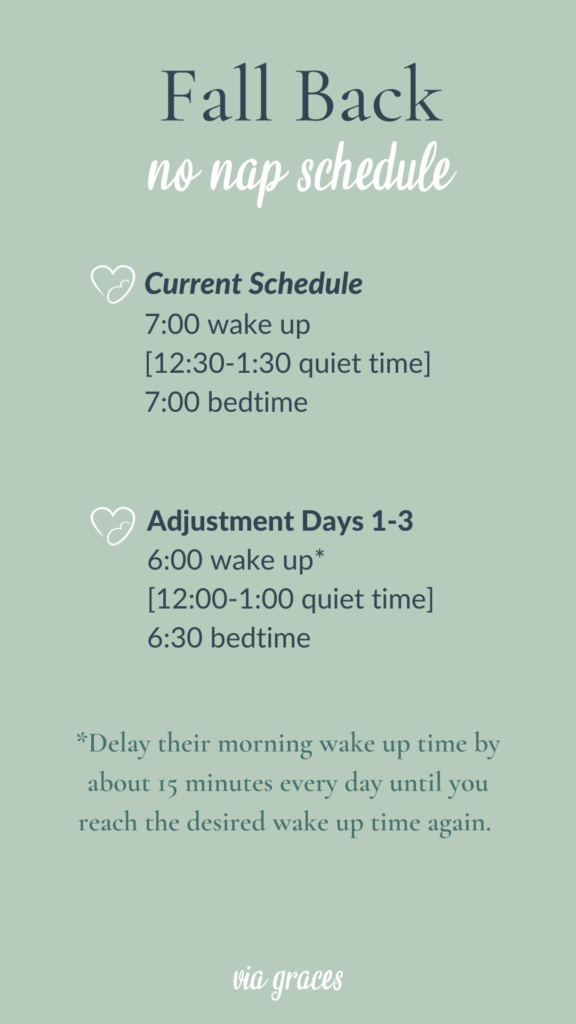
A Daylight Saving Time Tip for Adult Sleep, Too!
Helping our kids adjust to daylight saving time can be stressful enough, but it affects us, too! The biggest piece of advice we have for you (that helps your kids, too!), is to GET OUTSIDE!
Our body clocks can be very sensitive, and even with slight changes in schedules we can get easily thrown off, so make sure both you and your kiddos are getting outside during this adjustment. Getting outside, specifically in the morning and around sunset, helps our body clocks adjust!
Conclusion
The purpose of this post is to help you understand what’s actually happening when we “fall back” and recognize that it will likely impact your child’s sleep schedule in one way or another, depending on their age. From there, you can either choose to have a plan you follow that first week to help them adjust, or your plan can be to go with the flow!
Also remember that no matter what “plan” you choose to follow, we’re all going to end up back on the same timezone within about a week or so, so it’s all good.
If reading about having your child on any kind of schedule sounds foreign to you (whether by awake window or set times), or daylight savings is the least of your worries because you’re up all hours of the night trying to coerce your child to sleep anyway, we’d love to chat with you!
Sign up for a FREE discovery call so we can hear more about your child’s sleep and explain how we can help.
With Grace,
Lauren
